What is La Pausa Football?
‘La Pausa’ is a term commonly used in football.
It literally means ‘The Pause’ and describes a player’s ability to slow down the game’s pace, take control of the ball, and assess the situation around them.
It is a technique used by midfielders and playmakers to create space, read the game, and make effective decisions on the field.
This technique is widely associated with Spanish and South American players.
In essence, La Pausa is a player’s ability to pause the game, take a breath, and make an informed decision.
It requires a high level of technical ability, tactical awareness, and mental strength.
The technique manipulates the opposition by slowing down the tempo of the game or speeding it up when necessary.
It is often used to give teammates time to get into better positions or to draw defenders out of position to create space for other players.
La Pausa is often attributed to players who are known for their vision, creativity, and ability to control the tempo of the game.
Players like David Silva, Xavi Hernandez, Andres Iniesta, and Lionel Messi are often cited as examples of players who excel at this skill.
These players have the ability to control the ball, read the game, and make split-second decisions that can change the outcome of a match.
La Pausa’s technique involves slowing down and controlling the game.
This requires a player to be patient, calm and composed while under pressure.
By taking control of the ball, a player can change the momentum and give their team a chance to control the flow of the game.
Players who use La Pausa to great effect are often considered to be among the best in the world, and their ability to slow down the game and make informed decisions is a key factor in their success.
The Origins of La Pausa
The origins of La Pausa stem from South America.
Let me tell you about Ricardo Bochini, the legendary Argentine midfielder who is regarded as one of the greatest players in the history of the game.
Bochini was THE master of La Pausa, the art of slowing down the game and controlling the pace of play, but his impact on the game went far beyond that.
Bochini spent his entire career with Independiente, one of the most successful clubs in Argentine football history.
He joined the team as a teenager in 1972 and quickly became a key player, helping the team win multiple domestic and international titles.
But it wasn’t until the 1980s that Bochini really hit his stride.
During that decade, Bochini was the heart and soul of Independiente’s team, leading them to four Copa Libertadores titles and two Intercontinental Cups.
His skill on the ball was unmatched, and he had a remarkable ability to create chances for his teammates and score goals himself.
What really set Bochini apart was his mastery of La Pausa.
He had a way of slowing down the game and dictating the pace of play that was truly unique.
He would hold onto the ball, wait for the right moment, and then unleash a perfectly timed pass or shot.
It was a skill that few players possessed at the time, and it made Bochini a true innovator.
Bochini’s impact on the game of football cannot be overstated.
He was a trailblazer, a player who created new ways of thinking about the sport and inspired generations of players to come.
His legacy lives on today in the countless players who have tried to emulate his skill and style.
If you want to understand the true beauty of football, you need to look no further than Ricardo Bochini.
Players who have mastered the art of La Pausa
Lionel Messi
Who else could we begin with?
I mean, where do I even start when it comes to Lionel Messi and La Pausa?
This man has taken the art of slowing down the game to a whole new level, and it’s nothing short of mesmerising.
Messi has perfected this skill to an almost supernatural level.
Watching Messi play is like watching a masterclass in football strategy.
He seems to have this innate sense of exactly when to pause and when to strike.
It’s like he’s reading the game three steps ahead of everyone else.
And when he does decide to make his move, it’s so smooth and appears so easy that you almost forget how much thought and calculation went into it.
I think one of the things that makes Messi so great at La Pausa is his incredible vision.
He can see things on the field that most players wouldn’t even notice.
As he’s so patient and deliberate, he has the time to make the most of those opportunities.
He’s not just reacting to what’s happening in front of him; he’s actively shaping the game.
The images below depict Messi, in his Barcelona days, actively scanning the pitch, assessing viable passing options.
He pauses for two seconds
, and during that time, two Atlético Madrid defenders move closer to him,which means there is a pass on to Rakitic.
The Croatian midfielder then has plenty of space to execute a short pass to the forward, who can move across the defender.
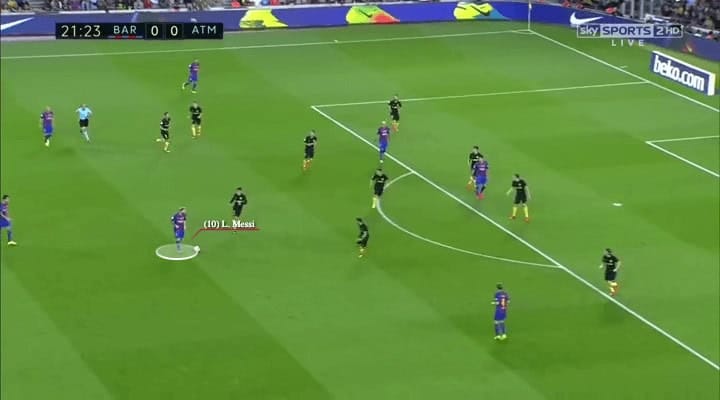
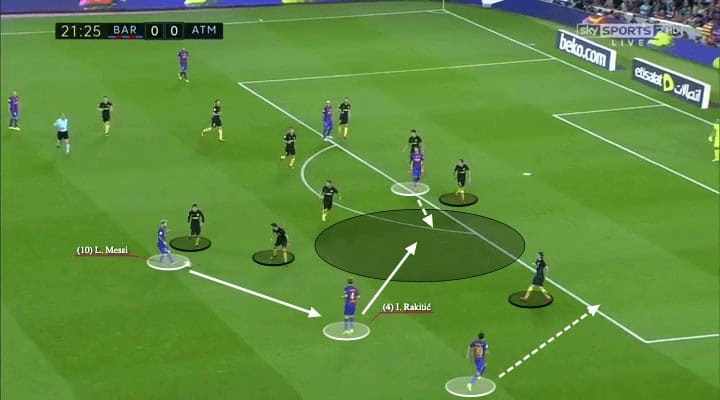
The forward then has the opportunity to play a round-the-corner pass to the marauding full-back, who can play a ball across the face of goal to Neymar.
This move sounds simple but requires incredibly intricate passes timed to perfection.
It all starts with Messi executing La Pausa.
What sets Messi apart is the way he combines La Pausa with his other skills.
He’s not just a master of slowing down the game; he’s also one of the most skilled dribblers, passers, and finishers in the world.
When you put all those things together, you get a truly unstoppable player.
In short, Lionel Messi and La Pausa are a match made in football heaven.
Andrés Iniesta
It’s impossible to talk about La Pausa without mentioning the trio of Barcelona legends Andrés Iniesta, Sergio Busquets, and Xavi Hernández.
These players are undeniable masters of the technique.
Honestly, I could have written about any of the three for this article.
I’ve opted for Iniesta purely out of personal preference.
The Barcelona legend was one of my favourite players when I was younger, so I’ll never say no to any opportunity to wax lyrical about his abilities. Throughout his illustrious career, Iniesta’s use of La Pausa has been incredible to witness.
I selected the example below to demonstrate Iniesta’s use of La Pausa because it is a little different to the one used to showcase Messi’s usage.
The technique of La Pausa isn’t just about standing still; it’s about slowing the game down to entice opponents to try to win the ball.
Therefore, space is available for teammates to exploit.
In this game against Las Palmas, Iniesta receives the ball and simply slows the game down to a walking pace.
The result of this is four Las Palmas players following him, leaving space on the Barcelona left flank which could be used for a switch.
In this case, a gap opens up for a pass to a teammate who has made a forward run, thus the attack can be resumed at pace.
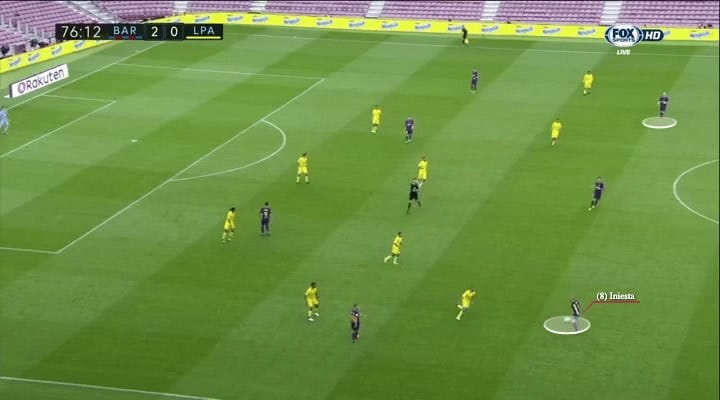
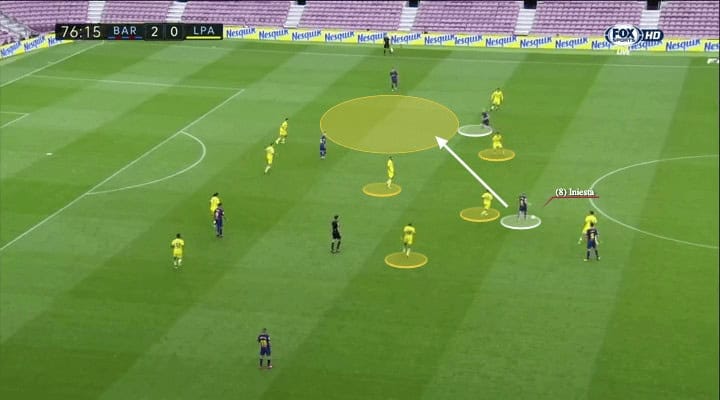
Éver Banega
Ever Banega is one of La Pausa’s greatest exponents — he has used it to significant effect throughout his career.
Banega’s success with La Pausa can be attributed to his exceptional vision and technique.
He has incredible ball control and can keep the ball close to his feet while assessing the situation around him.
This allows him to make quick decisions and execute precise passes.
There is a two-second ‘pause’ between the two images below; I’ve specifically selected this passage of play as it shows how La Pausa can influence opposition defenders.
Banega’s use of La Pausa lures the opposition defensive line to take a step back, creating space for his teammate to attack and receive his pass.
Other players in this situation may have opted to run at the defence and end up losing possession, or they would play the pass too early, meaning it could be intercepted.
It is Benega’s decision to use La Pausa that results in Sevilla retaining possession and being presented with an attacking opportunity.
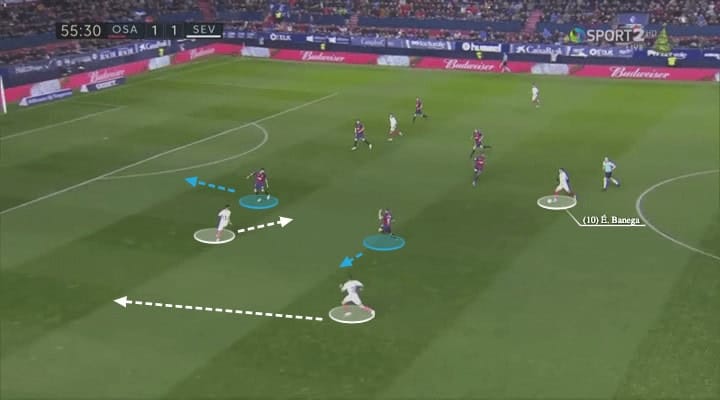
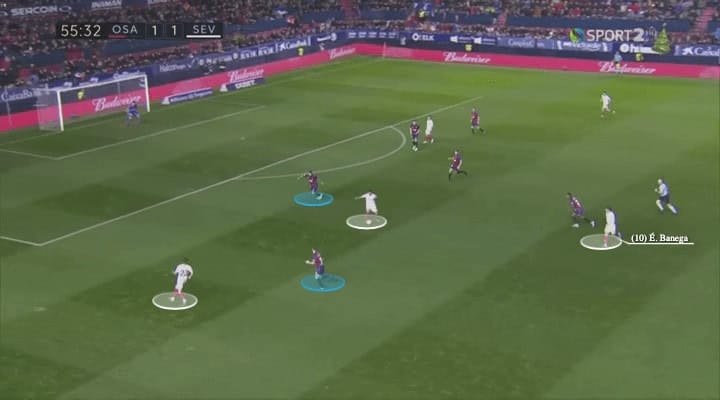
Banega’s use of La Pausa is not just limited to attacking situations.
He also has mastered how to use the technique to control the game defensively.
By slowing down the pace of the game, he can give his team a breather and help them regain their shape.
Banega’s use of La Pausa is a testament to his skill and intelligence as a footballer.
He has mastered this technique and made it a key part of his playstyle, allowing him to control the game and create opportunities for himself and his team.
Keira Walsh
Keira Walsh is brilliant.
She grew up watching the iconic Barcelona midfield of the aforementioned Iniesta, Xavi, and Busquets.
The Barcelona influence is coursing through the veins of her style of play.
She is the key component in Sarina Wiegman’s England team, and this has never been more evident than in the Euro 2022 tournament, which saw England crowned European Champions.
The images below are from the final against Germany, where Walsh used La Pausa to provide Ella Toone with the opportunity to make a run between the two German central defenders and score a delightful chip over the keeper to make it 1-0.
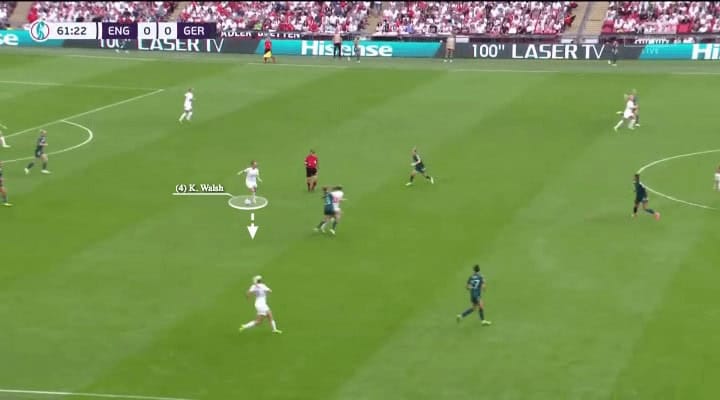
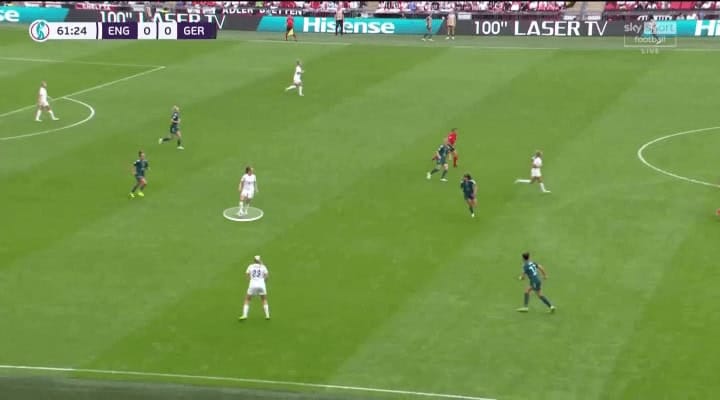
There are five seconds between Walsh receiving the ball and her inch-perfect pass landing at the feet of Ella Toone.
Firstly, it is important to acknowledge that the Germans’ defence was poor, as they failed to close down Keira Walsh, but nevertheless, the artfulness of the pass is exquisite.
The calmness and composure required to use La Pausa so eloquently in such a big game is something to be admired.
Lesser players may have looked to move the ball on quickly, or the nerves of the situation could have prevented them from executing the pass so well.
Instead, Keira Walsh took the time she needed to allow Ella Toone to run through the defence and then had the ability and confidence to play an incredible pass to her.
This is a prime example of a technically gifted player using La Pausa to influence a huge game, and as a result, a fantastic goal is scored.
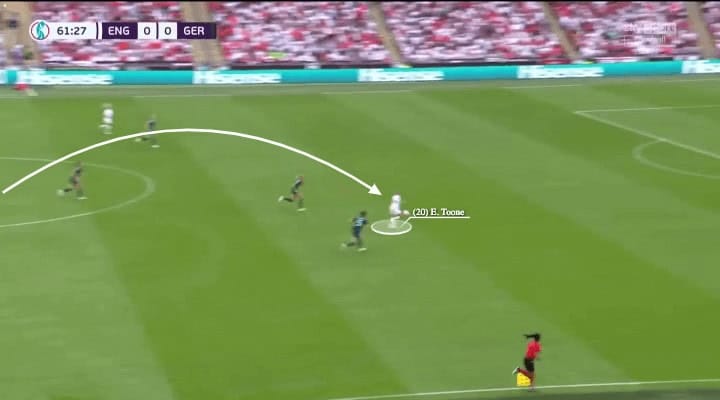
Pedri
Pedri is undoubtedly one of the most exciting young players in world football right now, and his mastery of La Pausa is a big reason why.
At just 20 years old, he’s already made a huge impact for both Barcelona and the Spanish national team, and many experts believe that he’s on his way to becoming a future legend of the game.
What sets Pedri apart is his incredible ability to slow down the game and make the right decisions in high-pressure situations.
Whether he’s dribbling past defenders, picking out a perfect pass, or creating space for himself, Pedri always seems to have an extra second to make his move.
He is already a master of La Pausa.
What’s remarkable about Pedri’s use of La Pausa is how natural it seems to him.
It’s as if he was born with the ability to control the pace of play and make the right decisions at the right time.
His vision, composure, and technical ability are all on display whenever he’s on the ball, and it’s clear that he’s a special talent with a bright future ahead of him.
Below is one of my personal favourite uses of La Pausa and a demonstration of Pedri’s footballing intelligence.
He receives the ball and stops.
Quite literally, he stands still.
Just for a second, but it is more than effective.
The Sociedad midfielder steps towards Pedri, thinking he has a chance to win the ball back.
Pedri beautifully flicks the ball past him and is able to carry the ball forward into the space that has opened up in front of him.
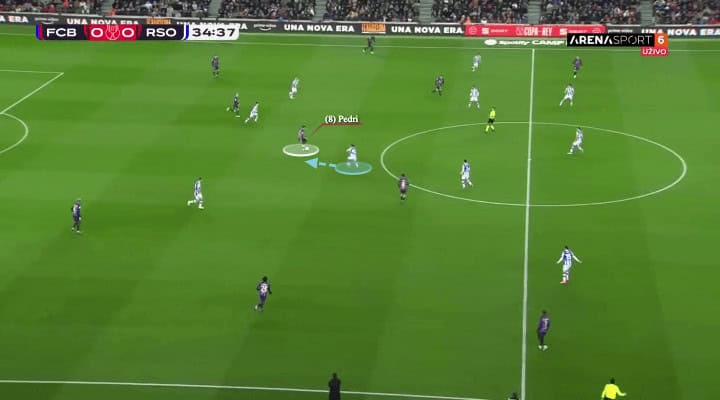
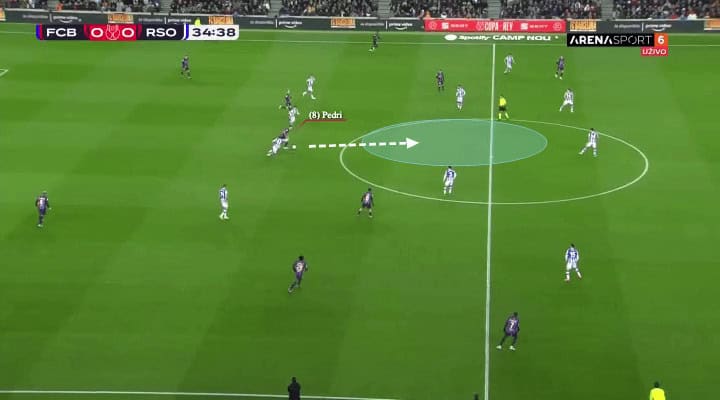
When you watch Pedri play, you can’t help but get excited about his potential.
He’s already shown that he can compete at the highest level, and he’ll only get better as he gains more experience and develops his game even further.
If he continues on this path, there’s no doubt that he’ll go down in history as one of the all-time greats of the sport.
Pedri’s mastery of La Pausa is just one aspect of his incredible talent, but it’s a skill that sets him apart from his peers and makes him a joy to watch.
He’s a player who can change the course of a game with a single moment of brilliance, and that’s what makes him a future legend of the game.
David Silva
Any article on La Pausa would be incomplete without mentioning the magician David Silva.
The Spaniard, one of the greatest players to
grace the Premier League stage, wowed fans weeklywith his intricate passing ability and eye for a pass.
He is able to read the game and anticipate the movements of his teammates and opponents, allowing him to create space and make the right decisions in a split second.
Below is a beautiful example of David Silva executing La Pausa.
He receives the ball in a tight space.
As the first image shows, the most obvious pass would be to Sergio Aguero, who is hovering in zone 14.
Instead, Silva opts to linger, just for a second, which draws the Bournemouth defender over to Aguero, whom he anticipates will be on the receiving end of Silva’s pass.
David Silva then lays a simple pass into the path of Raheem Sterling, who has made a run forward.
This is what truly makes Silva a master of La Pausa — his ability to execute the technique with such precision and elegance.
He is able to influence the opponent to create space with such ease and grace, that it almost seems effortless.
This mastery of the technique is what makes him such a joy to watch on the pitch.
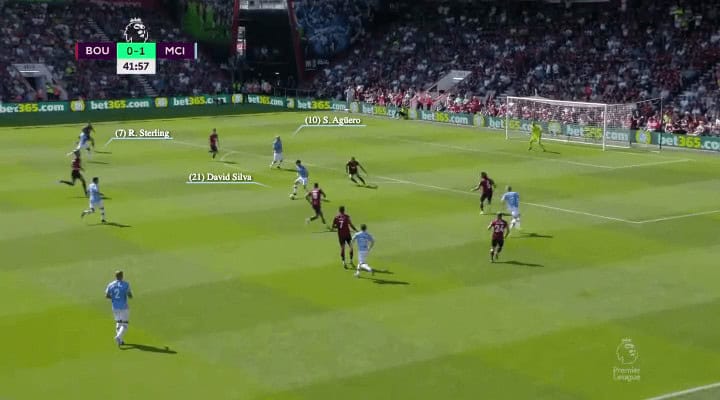
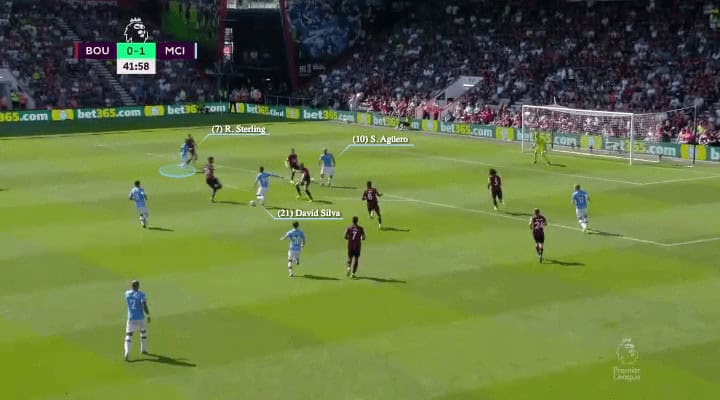
Conclusion
La Pausa has been used in football for many years, but it’s become much more frequently used in European football in recent times for several different reasons.
Firstly, the speed of the game has increased significantly over the years, and as a result, players are constantly under pressure to make quick decisions on the ball.
By using La Pausa, players are able to slow the game down and assess their options before making a decision.
This can help them to make better decisions and reduce the risk of making mistakes, which is particularly important in high-pressure situations.
Secondly, the modern game places a lot of emphasis on possession and controlling the tempo of the game.
La Pausa is a technique that can help players do just that, as it allows them to hold on to the ball and dictate the pace of play.
This can be particularly effective against teams that like to press high up the pitch, as it can help to break their defensive structure and create opportunities to attack.
Finally, many of the world’s best players are now using La Pausa in their games.
Players like Lionel Messi, Andrés Iniesta, and now Pedri have all mastered the art, and their success has inspired other players to adopt the technique.
As a result, we’re seeing more and more players using the technique as they look to emulate the success of these great players.
Overall, La Pausa is becoming more popular in European football because it’s a technique that can help players make better decisions, control the tempo of the game, and break down tough defences.
With more players adopting the technique, we can expect it to continue to be a key part of the game for years to come.

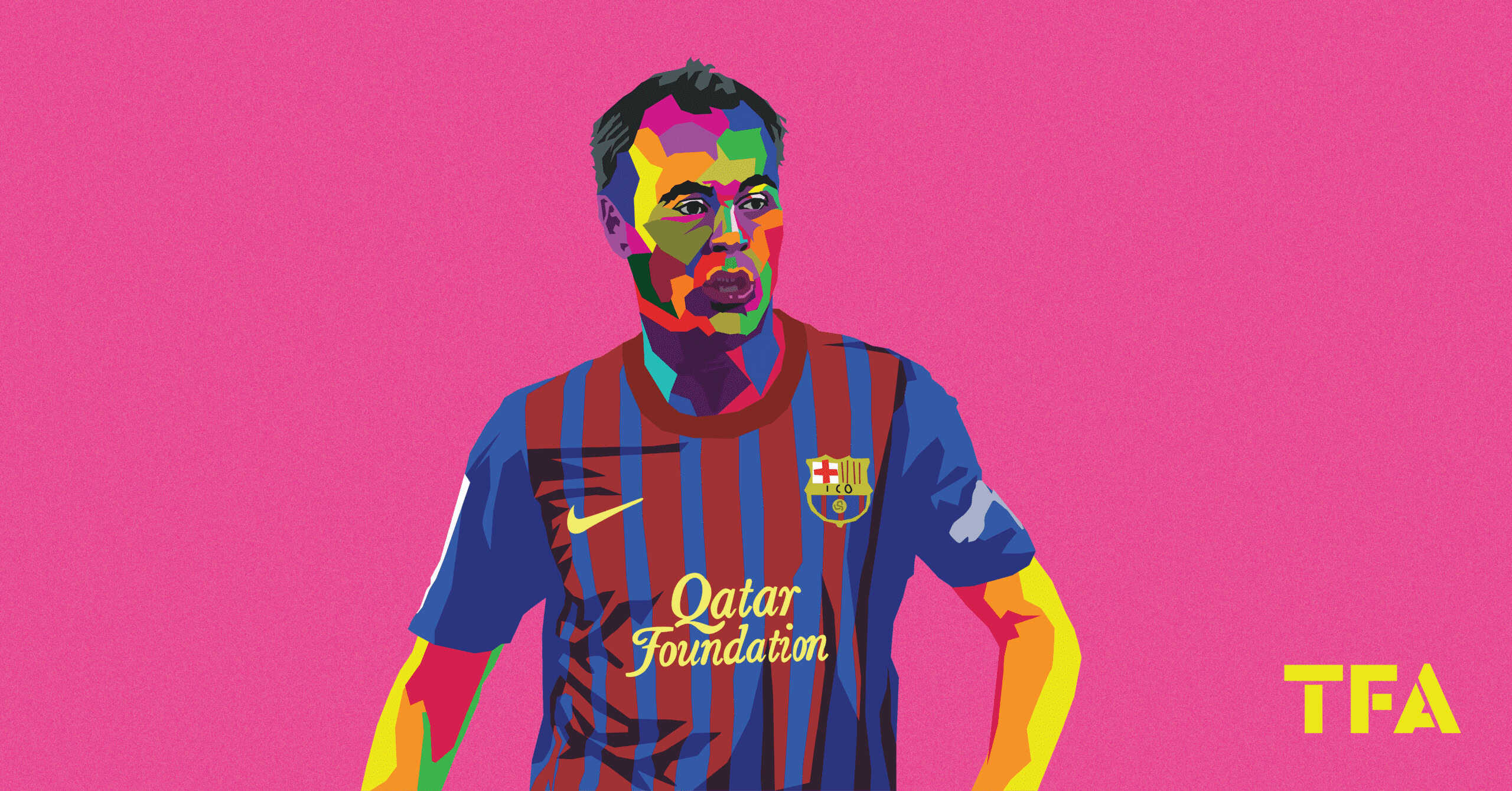



Comments